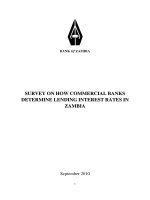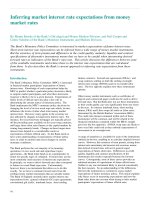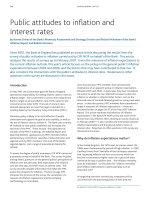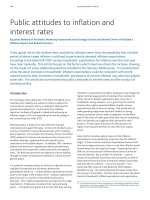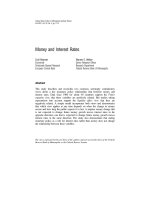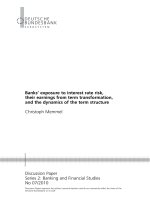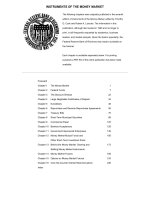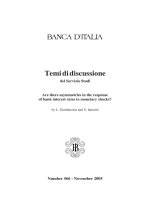What determines banks’ sensitivity to money market interest rates? pot
Bạn đang xem bản rút gọn của tài liệu. Xem và tải ngay bản đầy đủ của tài liệu tại đây (242.82 KB, 19 trang )
What determines banks’ sensitivity to money market interest rates?
P. Angelini* – V. Vacca
§
November 2004
Abstract
According to the martingale hypothesis, today’s overnight rate should equal its expected
value for tomorrow, as risk neutral banks should arbitrage away any deviation between the
two rates via instantaneous, theoretically infinite shifts of their demand for reserves across
days. Most empirical investigations reject this hypothesis and confirm that the interest rate
reactivity of the demand for reserves is far from infinite. Several explanations for these
findings have been proposed, but never systematically put to test. The present paper
performs such tests. In particular, we estimate the interest rate reactivity of the demand for
reserves for a cross section of Italian banks, and then study the determinants of these
elasticities. Among the determinants suggested by the available theory are fixed or
transaction costs, credit constraints, risk aversion, volatility of the end-of-day liquidity
shock. Our results indicate that for a large part of our sample the interest reactivity is
statistically zero; only for the remaining banks, typically of large dimension, it is
significant and negative. The analysis also validates some specific implications of the
model of demand for reserves under uncertainty, widely used in the literature on the money
market.
JEL classifications: E52
* Bank of Italy, Research department. Via Nazionale 91. 00184 Rome, Italy. Tel. 39-06-
4792.3308. Email:
§ Bank of Italy, Monetary policy operations department. Via Nazionale 91. 00184 Rome,
Italy. Tel. 39-06-4792.2528. Email:
2
1. Introduction
A well-known simple theory of the interbank market builds on the assumption that reserves are
held by banks only to meet the requirement, and hence that banks regard balances held on
different days of the averaging period as perfect substitutes. This theory has two strong testable
implications. First, the overnight interbank interest rate, typically used by most modern central
banks as an operational target, should behave like a martingale – the current value of the rate
should be the best predictor of tomorrow’s value (see e.g. Hamilton, 1996). Second, the
reactivity of the demand for reserves to the overnight rate should be infinite – tiny movements in
the rate should trigger shifts in the demand for funds large enough to eliminate predictable
patterns in the rate itself. A large literature has focused on testing the first implication,
consistently rejecting the martingale hypothesis (see e.g. Hamilton, 1997, Hayashi 2001, Prati et
al., 2003 for evidence on the US, Japan and the entire G7, respectively). The evidence
concerning the second testable implication is far less abundant, but also strongly rejects the
hypothesis that the interest rate elasticity of the demand for reserves is infinite (Hamilton, 1997;
Angelini, 2003).
Several explanations have been given for rejection of the theory, all involving a reason
why in practice reserves on different days of the maintenance period are not perfect substitutes.
These include market frictions such as fixed or transaction costs (Kopecky and Tucker, 1993;
Hamilton 1996; Clouse and Dow, 1999; Bartolini et al., 2001), credit line arrangements (Spindt
and Hoffmeister, 1988; Hamilton, 1996), generic liquidity benefits of reserves (Ho and Saunders,
1985; Campbell, 1987; Hamilton, 1996), payment system patterns and daily overdraft penalties
(Furfine, 2000), risk aversion on the part of banks (Ho and Saunders, 1985; Angelini, 2000),
specific features of the monetary policy operational framework (Pérez Quirós and Rodríguez
Mendizábal, 2003).
While these explanations are sometimes backed by empirical evidence, they have not yet
been systematically put to test. The purpose of the present paper is to perform such test. To this
end, we investigate the determinants of the interest rate sensitivity of banks’ demand for funds in
the interbank market. We proceed in two stages. First, we estimate a reserve demand equation
for each of the around 300 Italian banks in our sample, and retrieve a cross-section of estimated
interest rate semi-elasticities, one for each bank. If one or more of the elements suggested by the
above-mentioned literature are indeed relevant to explain rejection of the martingale
hypothesis/of the infinite elasticity of demand, then they should help explain the cross-section
dispersion of these elasticities. Therefore, in the second stage we regress the elasticities on a set
3
of explanatory variables suggested by the theory. Are credit constraints, say, rather than (or in
addition to) risk aversion, relevant to explain banks’ elasticity of demand, and hence the time
series patterns found in the overnight rate? Our results shed some light on such questions.
The analysis yields an empirical test of the well-known model of demand for reserves
under uncertainty introduced in the sixties by the seminal works by Orr and Mellon (1961),
Poole (1968), Baltensperger (1974), and still widely used in the more recent literature.
1
Specifically, the dynamic version of the model, which accounts for the reserve averaging
mechanism currently employed in most developed countries, yields particularly sharp predictions
about the effect of uncertainty on the interest rate elasticity: higher uncertainty about the end-of-
day reserve balance should unambiguously increase the elasticity at the end of the averaging
period. It should have an opposite effect during the period (see e.g. Whitesell, 2003; Pérez
Quirós and Rodríguez Mendizábal, 2003). Our daily dataset allows us to split the period and test
this prediction.
The following section provides a motivation for the experimental design. Section 3
describes the data; section 4 presents the time series estimates of the demand equations which
yield the semi-elasticities of interest. In section 5 the second stage analysis is performed.
Conclusions are summarized in the final section. Further details about the data are reported in the
appendix.
2. Motivation
This section heavily relies on Pérez-Quirós and Rodríguez Mendizábal (2003), to which we refer
for details about the model, and Whitesell (2003). Its purpose is to motivate the specification of
the demand for reserves estimated below, and to summarize available theoretical results that
suggest determinants of the interest rate reactivity. Consider a banking system populated of a
large number of banks. Let a
t
be the reserve position held by a representative bank at the
beginning of day t, c
t
the reserve deficiency (the cumulated difference between the reserve
requirement and the amount held) at the beginning of day t, b
t
be the amount lent (b
t
>0) or
borrowed in the interbank market during day t. Further, let i
t
be the overnight interest rate. The
bank is subject to an end-of-day liquidity shock ε
t
(ε
t
>0 denoting an inflow of funds), which is
realized after the market closes. Assuming a two-day settlement period, consider the final day,
denoted by T. At the end of the day, the liquidity position will be
a
T
+ ε
T
– b
T
.
Let p
T
=
c
T
+ b
T
1
See e.g. Guthrie and Wright (2000), Woodford (2000) for static versions, and Furfine (2000), Bartolini et al.
(2002), Pérez Quirós and Rodríguez Mendizábal (2003), Gaspar, Pérez Quirós and Rodríguez Mendizábal
(2004), Whitesell (2003), for dynamic versions; see also Clouse and Dow (1999), Bartolini and Prati (2003).
4
– a
T
.
If p
T
– ε
T
> 0, the bank will have to borrow funds at the marginal lending facility, incurring
the cost i
l
(p
T
– ε
T
). Vice-versa, if p
T
– ε
T
< 0 the bank will have to resort to the deposit facility,
earning i
d
(p
T
– ε
T
). Thus, expected profits from operating in the interbank market on T are given
by:
(1) )()()()(
T
p
TT
d
T
p
TT
l
TTT
T
T
dFpidFpibi
εεεεπ
òò
∞
∞−
−−−−=
Where F is the cdf of the shock ε
t
. Maximization of the above expression with respect to b
T
yields:
(2) i
T
= i
l
F(p
T
) + i
d
(1-F(p
T
))
Consider now day T – 1. Letting V
T-1
denote the value function on T – 1, the problem for
the bank on that day is:
1
111
)(max
−
−−−
+=
T
TTTT
b
VEV
π
Pérez-Quirós and Rodríguez Mendizábal (2003) show that the related first order condition is:
(3) i
T-1
= i
l
F(b
T-1
– a
T-1
) + i
d
[1-F(p
T-1
)] + )(
1
1
11
−
−
ò
−
−−
T
p
ab
T
T
tT
dFi
ε
Equations (2) and (3) provide suggestions about an empirical specification of a demand for
reserves. Specifically, (2) implies that reserve demand should be negatively related to the
overnight rate and positively related to the reserve deficiency. Also, the shape of the CDF of the
end-of-day liquidity shock may affect demand. In addition, (3) suggests that that the expected
rate should be positively related to the current demand on non settlement days (on the final day
of the period no intertemporal arbitrage is possible).
Adopting a normal density with mean zero and variance 2 for ε
t
, and a series of numeric
values for the parameters, equations (2) and (3) have been used to plot demand curves for days T
and T-1, in Chart 1. Similar charts can be found in Whitesell (2003). The curves have been
drawn under the assumption that i
l
=4, i
d
=2, so the relevant portion of the curve is around an
equilibrium rate of around 3 percent. The main indications concerning the interest rate elasticity
of demand emerging from the figure can be summarized as follows. First, on settlement day a
lower variance of the end-of-day liquidity shock reduces the elasticity (panel (a)); this result is
reversed on other days, when lower variance is associated with higher elasticity (panel (b)).
5
Second, if credit limits are binding the elasticity is reduced. Third, the elasticity is inversely
related to the width of the official interest rates corridor.
2
The above model assumes risk neutrality. However, it has been shown that risk aversion
can affect both the level of the demand for reserves and its interest rate elasticity (Ho and
Saunders, 1985). Specifically, higher risk-aversion should increase the demand for funds and
reduce its interest rate elasticity.
Finally, banks’ reactivity to interest rates may be influenced by the costs of setting up and
running an efficient cash management desk – including compensation of skilled treasurers,
hardware, software, rental of space and equipment, etc. While this factor has not been explicitly
emphasized in the literature,
3
it seems intuitive that if this cost is substantial, then a small bank
may rationally choose a simple rule to manage liquidity. For instance, a computer could be
instructed to invest (borrow) at the current overnight rate any amount of liquidity in excess
(short) of a target. For such a bank, the interest rate elasticity would be zero, yet this would be
consistent with rational behavior. These considerations loosely suggest that the higher a bank’s
volume of interbank activity, the larger the amount of resources invested in its cash management
desk, and the larger the reactivity of its demand for reserves to interest rates.
3. The data
Our daily dataset spans the period 1
st
January 1999 – 23
rd
January 2004. It includes various
money market rates and several variables at the individual bank level: the reserve requirement
and reserve balances held by each Italian bank at the Bank of Italy; measures of payment system
activity, based on the Italian real time gross settlement (RTGS) system, and of money market
activity, based on the Italian electronic interbank market (e-MID). A second part of the dataset
includes monthly and quarterly variables at the individual bank level. While most of these data
do display some amount of time variability, we mainly use them to measure banks’ fixed
characteristics (e.g. size) in the second stage of our analysis.
Several observations were dropped in the regression analysis. First, due to its phasing-in
features, the first maintenance period, from the 1
st
of January to the 23
rd
of February 1999, was
2
In our empirical analysis, based on the euro-area framework, this effect cannot be tested, due to insufficient
variation of the corridor width over the available sample period.
3
Bindseil et al. (2003) is an exception. They show that the daily cost for keeping a cash management desk open
late hours is of the order of 500 euros per day; this could be viewed as a lower bound for the cost of establishing
an efficient cash management desk. The role of fixed costs on a per transaction basis has been emphasized in the
literature (see. e.g. Hamilton, 1996; Furfine, 2003). While these costs can affect the elasticity of demand, they
are likely equal on a cross-section basis, and recorded no time series variation over our sample period. Therefore,
they are overlooked in the empirical analysis of the next sections
6
overlooked. Second, week-ends and holidays were dropped. Third, the first working day of each
maintenance period was used to calculate the lagged values of some variables. The full sample
period entails around 1,300 working days. However, some banks have fewer observations, due to
startups, closures, mergers and acquisitions, etc. Therefore, on a cross-section basis, we decided
to overlook banks with less than 300 observations. Also, some banks were excluded because key
time series are missing. After these exclusions, the full sample entails 266 banks. Details about
the construction of the variables and the filters adopted are in the appendix.
4. The demand for settlement balances
We began by estimating the following equation for each bank in our sample. Overlooking bank-
specific subscripts:
(4)
tt
s
t
ss
t
p
t
ps
t
iidiidr
σαααααα
31211210
)())(1( ++∆++∆−+=
−−
tt
e
tttt
rdrr
ηαωαωα
++++
−−−−− 16115114
In (4), r
t
stands for (log of the) end-of-day reserve balance held by the commercial bank
at the central bank, normalized by the bank’s current reserve requirement;
4
i
t
is the differential
between the overnight rate and the fixed/minimum rate for the main refinancing operations of the
Eurosystem, and ∆ is the first difference operator. The lagged i
t-1
term is introduced in the
regression to test whether interest rate levels play a role in addition, or in alternative, to first
differences. The dummy d
s
, which equals 1 during the final part of the maintenance period and
zero otherwise, is interacted with the interest rate terms to allow the elasticities to decline over
the period, as both theory and existing empirical evidence suggest. We experiment with different
definitions of “final part” of the maintenance period.
The remaining variables appearing in (4) are mainly introduced to allow for additional
flexibility in the specification and avoid biasing the estimates of the parameters of interest, in
particular of
i
1
α
, i = p, s.
t
σ
is a (time-varying) measure of the relevant source of uncertainty,
typically a random shock affecting the end-of-period liquidity position. The standard model of
reserves demand under uncertainty predicts that if the demand for excess reserves is positive,
then an increase in uncertainty should also increase demand; no effect should materialize if the
excess demand is zero. Thus, α
3
should be zero or positive. In what follows we proxy
t
σ
by a
conditional standard deviation of net daily payment flows, estimated by fitting an ARCH model
4
r
t
represents the counterpart of a
t
+ ε
t
– b
t
in section 2. In principle, one would want to use b
t
as the dependent
variable in (4). However, neither ε
t
nor a
t
are available in our dataset.
7
to the series (see the appendix for details).
5
1−t
r is the cumulated average excess reserve position
(the cumulated balance net of the reserve requirement) as a percentage of the requirement,
multiplied by the workoff rate
ω
t-1
. This magnitude, which represents the empirical counterpart
of the reserve deficiency (c
t
in section 2), is crucial in systems featuring averaging mechanisms,
such as those in use in the euro area and the US. The sign of
α
4
should be negative. The dummy
d
e
equals 1 when
1−t
r >0 and 0 otherwise. Its interaction with
1−t
r allows for an asymmetric
response to situations of cumulated reserve deficits or surpluses. Finally, r
t-1
is the lagged
dependent variable.
6
Equation (4) was estimated with instrumental variables, to account for potential
endogeneity problems between the dependent variable and i
t
. Specifically, yesterday’s tom-next
rate was used as an instrument for today’s overnight.
7
The monetary policy operational
framework adopted by the Eurosystem should be ideal for identifying a demand equation, since
the ECB’s main interventions, the so-called main refinancing operations (MROs), are conducted
on a weekly basis (fine-tuning operations were used only seldom during the sample period).
Thus, on any given day other than Wednesday, when MROs are settled, the total supply of
reserves changes only because of autonomous factors, which represent exogenous supply shifts
and therefore are perfect demand curve identifiers.
Since the regression output for each of the 266 banks in our sample would be rather
cumbersome to illustrate, in Table 1 we report the country-wide estimates, obtained as simple or
weighted averages of their bank-specific counterparts.
8
Several interesting facts emerge about
5
Since
t
σ
is meant to be a measure of uncertainty faced by the bank, it was computed from the balance stemming
from payments originated by clients’ transactions. In other words, we omitted payments related to monetary
policy and money market operations, which may be viewed as the bank’s endogenous reaction to the uncertainty
generated by client’s demands.
6
α
5
should be positive, as banks’ reaction to surpluses could be milder, given that in principle they are less costly.
In the absence of market frictions,
α
6
should be zero, as today’s demand for funds should be independent from
yesterday’s end-of-day balance, apart from the contribution of the latter to the cumulated reserve position
1−t
r .
However, if market frictions are relevant we could expect a positive autocorrelation in end-of-day balances. For
example, the bank could wish to work off relatively high balances in t-1 smoothly over subsequent days. Proxies
for risk aversion, suggested by the theory reviewed in section 2, are not included in (4) due to the fact that risk
aversion is likely to be relatively time invariant at the individual bank level. As a potential determinant of the
interest rate elasticity of demand, they are used in the next section, where we can exploit the cross-sectional
variability of our dataset.
7
A buyer of tom-next funds on day t acquires a right to receive the funds on day t+1 and a commitment to
reimburse them plus interest on t+2, at the interest rate agreed upon at t; this makes today’s tom-next rate a ready-
to-use proxy for expectations about tomorrow’s overnight.
8
This aggregation method provides consistent, although inefficient, results (Pesaran and Smith, 1995). Standard
errors retrieved via this method are correct as long as parameters are independent across banks. The weights for
the weighted average estimates are given by each banks’ average share of required reserves over our five year
sample period.
8
our main parameter of interest,
α
1
, the semielasticity of the demand for reserves to the interest
rate. Consider the regression in column (a’), where the interest rate elasticities have been
allowed to change in the final 5 working days of the maintenance period. For most of the period
a 10 basis points change in the overnight rate triggers a 14.8 percent adjustment in the demand
for reserves. In the last five days the demand elasticity drops to 1.1 percent. Second, the number
of banks for which
α
1
is in line with the a priori (negative and significant) is relatively small:
barely above one third of the sample in the first part of the period, about one fifth towards the
end of the period (last rows of the table). Third, larger banks tend to be more interest rate
sensitive, as indicated by the fact that size-weighted average estimates of
α
1
are about twice as
large than their simple average counterparts in column (a). Finally, the coefficient of the lagged
interest rate level is also significant; however, it is relatively small in absolute value, indicating
that demand behavior is predominantly affected by interest rates changes, rather than levels. The
effect of the variability of payment flows is not statistically different from zero. This could be
due to the fact that the demand for excess reserves is positive but very close to zero. Overall, the
results obtained by focusing on the last 10 working days of the working period remain broadly
unchanged.
Chart 2 presents the cross-sectional distribution of the individual bank estimates of
p
1
α
and
s
1
α
summarized in column (a), which we use as dependent variables in the next section.
While most of the mass is clustered around zero, the density of
p
1
α
in panel (a) exhibits the
expected asymmetry toward negative values. In some cases the semi-elasticity is even positive
and significant.
9
Within the group of interest rate sensitive banks, the absolute value of
α
1
lies on
average in the range 1.8 – 1.9, with an individual maximum of 5.1. The cross-section distribution
of
s
1
α
in panel (b) is more symmetric and clustered around zero. Although the average remains
negative, there is an increase in the number of positive and significant coefficients.
5. The determinants of the semi-elasticity to interest rates
What determines the size of the parameter α
1
? According to the theory reviewed in section 2, the
absolute value of the elasticity to the interest rate should be inversely related to the bank’s degree
of risk aversion, and can be reduced by the presence of credit limits. In addition, we saw that the
9
Some of these banks result from merger operations towards the end of the sample period. The wrong sign for the
elasticity might be due to the few observations available after the merger. According to influence indicators, the
other regressions are heavily affected by a few observations, clustered around key sub-periods, like December 31,
1999 (the date changeover) and December 31, 2001 (the euro cash changeover). If these observations are dropped
from the sample period, the incorrect elasticity from the regression results is much weaker.
9
model of precautionary demand delivers particularly sharp predictions about the effect of
uncertainty faced by the bank due to its payment system activity. Specifically, lower uncertainty
should reduce the elasticity (increase its absolute value) in the initial part of the period, and
increase it at the end, when banks can no longer resort to intertemporal arbitrage. Finally, we
argued that the payoff from an efficient cash management desk should increase with the volume
of interbank activity, and that therefore the elasticity of demand should be related to a bank’s
size. Indeed, results in the previous section suggest that large banks are significantly more
interest rate elastic than average.
In what follows we try to assess the role of these different factors by regressing the
estimated coefficients α
1
from equation (4) on a series of bank-specific proxies. As a measure of
uncertainty concerning daily net reserve flows we use the unconditional standard deviation of the
net daily payments balance, normalized by the bank’s reserve requirement.
10
Two proxies were
used for the banks’ unobservable degree of risk aversion. The first, specifically related to
liquidity management activities, is given by the standard deviation of daily cumulated excess
reserves normalized by required reserves, computed over the entire sample period. Spindt and
Hoffmeister (1988) argue that a risk-averse treasurer will want to keep her balance always close
to the requirement, to avoid being exposed to interest rate swings in the remaining part of the
maintenance period. Thus, for a risk-averse bank this standard deviation should be relatively
small.
11
An alternative measure is given by the (size adjusted) difference between a bank’s actual
and required capital, according to the Basel Committee definition, based on the hypothesis that
higher levels of excess capital may reflect more conservative behavior.
Our dataset contains a direct measure of borrowing constraints. Some Italian banks
operate on the money market through other institutions, which typically enforce daily trading
ceilings on them. The imposition of a cap on a given bank is revealed in our dataset by an
indicator variable (the size of the credit caps is unfortunately not disclosed, nor is there
information about the days when they are binding). Under the assumption that the caps are
binding for a relevant portion of the sample period, these banks should be characterized by a
lower than average interest rate elasticity.
We experimented with various proxies of bank size, including total assets, total managed
funds, reserve requirements. We also looked for threshold effects. In the end, we retained the
(log of the) trading volume on the overnight segment of the e-MID, averaged over the entire
10
This was retrieved from the same estimation process as the conditional standard deviation used in equation (4).
11
One potential problem of this proxy is that it may record high values for a highly risk-averse bank facing large
end-of-day shocks, as well as for a risk-neutral bank facing small end-of-day shocks. However, we control for the
size of the end-of-day shock by via a measure of the variability of net payment flows among the regressors.
10
sample period. The proxy is consistent with the assumption, made in section 2, that the volume
of interbank trading justifies the costs of setting up an efficient trading desk. Finally, we control
mergers and acquisitions operations (M&As). Under the hypothesis that M&A increase
efficiency, a bank resulting from such an operation could become more reactive to interest rates.
A dummy variable was set to 1 for these banks, and 0 otherwise.
12
Table 2 summarizes the results of this stage of the analysis. In interpreting the
coefficients it must be remembered that variables with a negative sign increase the (absolute
value of the) elasticity, and vice-versa. Columns (a) and (a’) report results obtained using in the
order
p
1
α
and
s
1
α
as the dependent variable when the dummy d
s
is set to 1 for the final 5 working
days of the maintenance period. Columns (b) and (b’) report results obtained with
p
1
α
and
s
1
α
from the corresponding columns of Table 1.
Consider specifications (a) first. The coefficient of the variability of payment flows is
positive and highly significant: in the first part of the period banks facing relatively high
uncertainty about their payment flows appear less ready to react to interest rate movements. The
opposite effect prevails in the last days of the period, when the same banks are relatively more
reactive: in column (a’) the coefficient becomes negative and significant. As discussed in section
2, this result is in line with the prediction of the standard model for precautionary reserves. Our
first proxy for risk aversion, the standard deviation of daily excess reserves, which should
capture liquidity manager-specific characteristics, has a positive and significant effect, in line
with some theories (Ho and Saunders, 1985). The effect of the other proxy, bank’s excess
capital, is not significant. The regression also confirms Hamilton’s (1996) intuitive simulation
results: credit constrained banks consistently display a lower interest rate sensitivity, at least for
most of the maintenance period. The coefficient of our size indicator – money market trading
volume – has the expected sign and is significant. Based on the estimates in column (a), each
time the bank’s turnover on the money market doubles, the absolute value of the semi-elasticity
increases by 0.7 basis points. Finally, the coefficient related to the M&As dummy variable is not
statistically different from zero. One explanation for this result could be lack of power, as our
sample period may be too short for the efficiency gains brought about by mergers to show up.
13
12
Specifically, the daily data of each merged bank were split in an “old” and a “new” time series; the regression (4)
was then re-run separately for each. Operations that took place very early or very late in the sample period were
dropped, because the time series of the “old” or the “new” bank would have been too short to run the first stage
regression.
13
Focarelli and Panetta (2003) show that efficiency improvements of mergers and acquisitions in a sample of
Italian banks tend to show up in the data about 2 years after the operation.
11
Regression (a’), in which
s
1
α
was used as the dependent variable, has a very low
explanatory power. Whereas some of the effects showing up in specification (a) are lost, the
coefficient of bank size remains negative and significant. The coefficient of our second proxy for
risk aversion becomes negative and statistically significant. This is at odds with our a priori, and
may deserve further analysis. The regressions in columns (b) and (b’), derived from the
elasticities estimated with the alternative split of the sample period, broadly confirm the findings
from columns (a) and (a’).
6. Conclusions
The hypothesis that the short-term interbank interest rate should behave like a martingale, and
the ancillary hypothesis that the interest rate sensitivity of the banks’ demand for funds should be
infinite, have been rejected by a large body of empirical literature for the main international
money markets. This paper tests some of the theoretical explanations that have been put forward
for these findings. In the first stage of the analysis, estimates of the interest rate elasticity of
demand are derived by running time series regressions for each bank in our sample. Next, using
the cross-section dimension of the data, these elasticities are regressed against a series of proxies
of the explanatory factors suggested by the available theory. The main conclusions can be
summarized as follows.
First, the aggregate elasticity of demand for reserves, computed as an average of
individual estimates for each bank, is found to be finite and significant: over the first three
working weeks of the maintenance period a 10 basis points change in the overnight rate triggers
a 15 percent adjustment in the demand for reserves. In the last five days of the period the
elasticity drops to 1 percent. Second, substantial heterogeneity of behavior is detected across
banks in our sample: for about 65 to 70 percent of them, typically of small-medium size, the
elasticity is statistically zero even in the initial part of the period. The banks displaying a nonzero
elasticity are generally large. This finding helps explain the low values of the elasticity often
detected in empirical work relying on aggregate time series. Third, the demand for reserves does
not seem to be directly affected by the degree of uncertainty concerning exogenous net payment
flows.
The second stage of the analysis confirms some of the theoretical explanations of a low
interest rate reactivity of the demand for reserves, with a few qualifications. We find that banks
facing borrowing constraints (credit caps) in the interbank market tend to be less interest rate
sensitive. Second, a bank’s interest rate sensitivity tends to grow nonlinearly with its size. While
not emphasized thus far in the theoretical literature, this finding can be rationalized via effects
12
generated by the costs of setting up and running a high quality cash management desk. Third,
based on our proxies for banks risk attitude, there is some evidence that higher risk aversion is
associated with lower interest rate reactivity, in line with some of the theoretical literature (e.g.
Ho and Saunders, 1985). Finally, we find that the effect of uncertainty on the interest rate
reactivity changes sign over the maintenance period: in the final days, higher uncertainty
concerning end-of-day net reserve flows increases reactivity, whereas for most of the period the
opposite effect prevails. This finding is in line with recent dynamic versions of the classic Orr-
Mellon-Poole model of reserve demand (see e.g. Pérez Quirós and Rodríguez Mendizábal, 2003;
Whitesell, 2003). To our knowledge, this result represents the most clearcut empirical
confirmation of this model available in the literature.
13
References
Allen, L., and A. Saunders (1986) “The Large – Small Dichotomy in the Federal Funds
Market”, Journal of Banking and Finance, 10, 219–230.
Allen, L., S. Peristiani and A. Saunders (1989), “Bank Size, Collateral, and Net Purchase
Behavior in the Federal Funds Market: Empirical Evidence”, Journal of Business 62,
501–516.
Angelini, P. (2000), “Are Banks Risk Averse? Intraday Timing of Operations in the
Interbank Market”, Journal of Money, Credit and Banking, 32, 54–73.
Angelini, P. (2003), “Liquidity and Announcement Effects in the Euro Area”, mimeo, Banca
d’Italia.
Angeloni, I., and E. Bisagni (2002), “Liquidity Effects in the Euro Area”, mimeo, European
Central Bank, July 2002.
Baltensperger, E. (1974), “The Precautionary Demand for Reserves”, American Economic
Review, 64, 205–210.
Bartolini, L. and A. Prati (2003), “Cross-Country Differences in Monetary Policy Execution
and Money Market Rates’ Volatility”, mimeo.
Bartolini, L., G. Bertola and A. Prati (2001), “Banks’ Reserve Management, Transaction
Costs and the Timing of Federal Reserve Intervention”, Journal of Banking and
Finance, 25, 1287–1317.
Bartolini, L., G. Bertola and A. Prati (2002), “Day-To-Day Monetary Policy and the
Volatility of the Federal Funds Rate”, Journal of Money, Credit and Banking, 34,
137–159.
Bindseil, U., and F. Seitz (2001), “The Supply and Demand for Eurosystem Deposits the
First 18 Months”, European Central Bank, Working Paper No. 44, February 2001.
Bindseil, U., G. Camba-Mendez, A. Hirsch, and B. Weller (2003), “Excess Reserves and the
ECB’s Implementation of Monetary Policy”, mimeo.
Borio, C.E.V. (1997), “Monetary Policy Operating Procedures in Industrial Countries”, in
“Implementation and Tactics of Monetary Policy”, Bank for International
Settlements, 1997.
Campbell, J.Y. (1987), “Money Announcements, the Demand for Bank Reserves, and the
Behavior of the Federal Funds Rate within the Statement Week”, Journal of Money,
Credit, and Banking, 19, 56–67.
Clouse, J.A., and James P. Dow jr. (1999), “Fixed Costs and the Behavior of the Federal
Funds Rate”, Journal of Banking and Finance, 23, 1015–1029.
European Central Bank (2002), “The Single Monetary Policy in the Euro Area”, European
Central Bank, Frankfurt am Main, Germany.
Focarelli, D., and F. Panetta, (2003), “Are Mergers Beneficial to Customers? Evidence from
the Market for Bank Deposits”, American Economic Review, 93, 1152–1172.
Furfine, Craig H. (2000), “Interbank Payments and the Daily Federal Funds Rate”, Journal of
Monetary Economics, 46, 535–553.
Furfine, Craig H. (2003), “The Fed’s New Discount Window and Interbank Borrowing”,
mimeo.
14
Gaspar, V., G. Pérez Quirós and H. Rodríguez Mendizábal (2004), “Interest Rate
Determination in the Interbank Market”, mimeo.
Guthrie, G. and J. Wright (2000) “Open mouth operations”, Journal of Monetary Economics
46, 489–516.
Hamilton, J.D. (1996), “The Daily Market for Federal Funds”, Journal of Political Economy,
104, 26–56.
Hamilton, J.D. (1997), “Measuring the Liquidity Effect”, American Economic Review, 87,
80–97.
Hayashi, F. (2001), “Identifying a Liquidity Effect in the Japanese Interbank Market”,
International Economic Review, 42, 287-315.
Ho, T.S.Y., and A. Saunders (1985), “A Micro Model of the Federal Funds Market”, The
Journal of Finance, 40, 977–988.
Kopecky, K.L., and A.L. Tucker (1993), “Interest Rate Smoothness and the Nonsettling-Day
Behavior of Banks”, Journal of Economics and Business, 45, 297–314.
Murphy, K.M., and R.H. Topel (1985), “Estimation and Inference in Two-Step Econometric
Models”, Journal of Business & Economic Statistics, 3, 370-379.
Orr, D., and W.G. Mellon (1961), "Stochastic Reserve Losses and Expansion of Bank
Credit", American Economic Review, 51, 614–623.
Pérez Quirós, G., and H. Rodríguez Mendizábal (2003), “The Daily Market for Funds in
Europe: What has Changed With the EMU?”, UAB-IAE Working Paper 559.03.
Pesaran, M. H., and R. Smith (1995), “Estimating Long-Run Relationships from Dynamic
Heterogeneous Panels”, Journal of Econometrics, 68, 79–113.
Poole, W. (1968), “Commercial Bank Reserve Management in a Stochastic Model
:
Implications for Monetary Policy”, Journal of Finance, 23, 769–791.
Prati, A., L., Bartolini and G. Bertola (2003), “The Overnight interbank Market: Evidence
From the G7 and the Euro Zone”, Journal of Banking and Finance, 27, 2045–2084.
Spindt, P.A., and J.R. Hoffmeister (1988), “The Micromechanics of the Federal Funds
Market: Implications for Day-of-the-Week Effects in Funds Rate Variability”,
Journal of Financial and Quantitative Analysis, 23, 401–416.
Stracca, L. (2003), “Demand and Supply in the ECB’s Main Refinancing Operations”,
forthcoming, Journal of Banking and Finance.
Whitesell, W. (2003), “Tunnels and Reserves in Monetary policy Implementation”, Finance
and Economics Discussion Series n° 28, Federal Reserve Board, Washington, D.C.
Woodford, M. (2000), “Monetary Policy in a World Without Money”, International Finance,
3, 229–260.
15
Table 1: Dependent variable: log of end-of-day reserve balance, r
t
(Instrumental variables estimates of equation (4))
“End of period” defined as last 5
working days
“End of period” defined as last 10
working days
Simple Weighted Simple Weighted
Averages Averages Averages Averages
(a) (a’) (b) (b’)
Constant –0.03** –0.16 –0.04** –0.20
(0.02) (0.14) (0.02) (0.15)
∆i
t
(1
st
part of period)
p
1
α
–0.64** –1.48** –0.67** –1.58**
(0.01) (0.10) (0.01) (0.10)
∆i
t
(end of period)
s
1
α
–0.08** –0.11* –0.12** –0.23**
(0.01) (0.06) (0.01) (0.05)
i
t-1
(1
st
part of period)
p
2
α
–0.20** –0.46** –0.23** –0.61**
(0.01) (0.04) (0.01) (0.05)
i
t-1
(end of period)
s
2
α
0.02** 0.08* –0.02** 0.03
(4.4e–3) (0.04) (3.7e–3) (0.03)
‘
t
σ
–6.2e–4** –5.6e–4 –5.3e–4** –2.7e–4
(1.4e–4) (1.1e–3) (1.4e–4) (1.1e–3)
ω
t-1
1−t
r
–0.14** –0.10** –0.14** –0.11**
(1.8e–3) (0.01) (1.7e–3) (0.01)
d
e
ω
t-1
1−t
r
–0.09** –0.20** –0.09** –0.19**
‘
(2.5e–3) (0.02) (2.5e–3) (0.02)
r
t-1
0.32** 0.29** 0.32** 0.28**
‘
(1.4e–3) (0.01) (1.5e–3) (0.01)
No. of regressions 266 266
Avg. No. obs. per regression 960 960
Avg. adjusted R
2
0.29 0.29
Share of banks with negative
and significant
1
α
at 5% level
34.6 % (1
st
part of period)
18.4 % (end of period)
33.8 % (1
st
part of period)
20.7 % (end of period)
Notes
r
t
is the log of the ratio between the end-of-day balance held by each bank at the central bank and the bank’s
current reserve requirement. The values in the table are obtained by estimating regression (4) in the text for each
individual bank in the sample, and by taking simple and weighted averages of the estimated coefficients and
heteroskedasticity robust standard errors (in brackets). Weighted averages are computed using each bank’s share
of the reserve requirement, averaged over the sample period. Each equation was estimated with instrumental
variables, using the previous day’s tom-next as an instrument for the current overnight (Eonia). Daily data;
sample period: February 24, 1999 – January 23, 2004. One or two asterisks denote significance at the 5 and 1
percent level, respectively.
16
Table 2: Dependent variable: estimated semi-elasticities to interest rates
“End of period” defined as last 5
working days
“End of period” defined as last
10 working days
Dependent variable:
p
1
α
(a)
s
1
α
(a’)
p
1
α
(b)
s
1
α
(b’)
Constant
–0.31** –0.02 –0.32** –0.04*
(0.06) (0.02) (0.06) (0.02)
Net payment flows variability
5.7e–5** –2.7e–5** 6.2e–5** –1.8e–5*
(2.0e–5) (9.6e–6) (2.0e–5) (8.0e–6)
Risk aversion
Treasurer’s behavior 0.11** –0.03 0.13** –0.02
(0.04) (0.04) (0.04) (0.03)
Bank’s excess capital 4.9e–3 –2.1e–2** 3.5e–3 –1.8e–2**
(0.01) (6.8e–3) (0.01) (6.6e–3)
Credit caps
0.51* –0.02 0.52* 0.06
(0.20) (0.05) (0.24) (0.05)
Bank size
–7.3e–3** –8.0e–4* –7.6e–3** –1.2e–3**
(1.3e–3) (3.7e–4) (1.4e–3) (3.7e–4)
Mergers & acquisitions (0/1 dummy)
–0.05 0.05 –0.05 0.03
(0.06) (0.03) (0.06) (0.02)
Dependent mean –0.16 –0.03 –0.17 –0.04
Number of observations 266 266 266 266
Adjusted R
2
0.08 0.03 0.09 0.03
Notes
Cross-section regressions of the individual bank semi-elasticities,
p
1
α
(first part of the maintenance period) and
s
1
α
(end of the period) from equation (4) in the text (summarized in Table 1), on the set of explanatory variables
listed in the first column. See the appendix for the definition of the regressors. The regressions have been
estimated by weighted least squares, where the weight of each observation is inversely proportional to the
standard error of the estimated
1
α
. The dependent variable mean is weighted accordingly. Heteroskedasticity
robust standard errors are reported in brackets. One or two asterisks denote significance at the 5 and 1 percent
level, respectively.
17
Chart 1: A theoretical demand for reserves
(a) Settlement day (equation (2))
(b) non settlement day (equation (3))
Note: The curves are drawn using equations (2) and (3) in the text, under the assumption that the liquidity
shock ε
t
is normally distributed with mean zero. For the benchmark curves, we use the following numerical
values for the parameters:
2
ε
σ
=2, i
l
=4, i
d
=2, a
t
= 5, c
T
=5 in equation (2) and c
T-1
= 10, i
T
=3 in equation (3). For
the “narrower corridor” curve we set i
l
=3.5, i
d
=2.5. For the “lower variance” curve we set
2
ε
σ
=.5.
1.8
2.2
2.6
3
3.4
3.8
4.2
-10-8-6-4-20246810
reserves
interest rate
lend
ld
borrow
- larger reserve deficiency
- lower beginning-of-day reserve level
lower variance of end-of-day
liquidity shock
narrower corridor
benchmark
Cre diti c eiling is
binding
1.8
2.2
2.6
3
3.4
3.8
4.2
-10-8-6-4-2 0 2 4 6 810
reserves
interest rate
na rro w e r co rridor
benchm ark
- larger reserve deficiency
- lower beginning-of-day reserve level
lower variance of end-of-day
liquidity shock
lend bo rro w
credit ceiling is binding
18
Chart 2: Frequency distribution of estimated interest rate elasticities
(a)
p
1
α
(first part of the maintenance period)
(b)
s
1
α
(end of the maintenance period)
Note:
The chart is based on the estimates of
α
1
summarized in Table 1, column (a). The shaded areas and the
related figures within the histograms refer to the number of banks for which the estimated
α
1
is
statistically significant at least at the 5 percent level.
37
9
18
19
11
8
3 2 1 3
0
10
20
30
40
50
60
70
80
<-2,0 -2,0 to -1,5 -1,5 to -1,0 -1,0 to -0,5 -0,5 to 0,0 0,0 to 0,5 0,5 to 1,0 1,0 to 1,5 1,5 to 2,0 >=2,0
Interval for elasticity estimates
Number of bank
s
2 1
7
13
27
10
5 3 0 0
0
20
40
60
80
100
120
<-2,0 -2,0 to -1,5 -1,5 to -1,0 -1,0 to -0,5 -0,5 to 0,0 0,0 to 0,5 0,5 to 1,0 1,0 to 1,5 1,5 to 2,0 >=2,0
Interval for elasticity estimates
Number of bank
s
19
Appendix
1. Sample definition
We considered the set of Italian banks that over the period from 24 February 1999 to 23 January
2004 had a non-zero reserve requirement, held a current account at the central bank, and
participated directly in the Italian real time gross settlement system Bi-rel. This selects a set of 428
banks, about 50 percent of the universe of Italian banks in terms of number and over 99.5 per cent
in terms of the reserve requirement. Most of the banks excluded are cooperative credit banks
which fulfill their reserve requirement through an intermediary or are too small to have a
requirement in excess of the deductible. Next, we dropped banks with less than 300 time series
observations. These are mainly due to startups, cessations, or banks that at some point in time
decided to fulfil the requirement through another bank, and therefore closed their account at the
central bank (or those that did the opposite). Also, we dropped banks whose time series displayed
unaccountable structural breaks. This reduces the number of banks to 266.
2. Variables definition. - For each bank, variables are calculated as follows.
Daily time-series regressions in section 4:
r
t
log of the ratio: End-of-day balance on the current account held at the central bank/Reserve
requirement over the relevant period.
i
t
Eonia (Euro overnight index average) rate minus the fixed/minimum rate on main refinancing
operations (MRO), the main policy rate of the Eurosystem (over the period 1 January 1999 –
25 June 2000 MROs were allotted at a fixed rate; subsequently the auction mechanism was
changed into a variable-rate tender, with a minimum bid rate). In the instrumental variables
estimation, the t-1 tom-next (computed as a volume-weighted average; source: Italian
electronic interbank market e-MID) was employed as an instrument for i
t
.
ω
t-1
workoff rate, ω
t-1
= 1/(T – t +1), where T is the length of the maintenance period and t is the
number of days from the start of the period. See Spindt and Hoffmeister (1988).
1−t
r cumulated excess reserve position:
ú
û
ù
ê
ë
é
−
−
≡
å
−
=
− ii
t
i
it
RRRRR
t
r /)(
1
1
1
1
1
, where R
i
and RR
i
are the
end-of-day balance and the reserve requirement on day i, respectively.
t
σ
conditional standard deviation of the ratio: net payment flows/reserve requirement. Only
payments originated by clients’ transactions and sent on the Italian real time gross settlement
system were considered; payments originated by the bank, such as those related to money
market or monetary policy operations, were overlooked.
t
σ
was retrieved by estimating an
ARCH model for each bank. Weighted average estimates (using the average reserve
requirement over the sample period) are as follows: Intercept: –3.31; AR(1): +0.20; AR(2):
+0.09; ARCH(1): +0.28; Avg. No. of observations: 706 (further details are available from the
authors).
Cross-section regressions in section 5:
Payment flows variability. It is the analogue of σ
t
, as it is the unconditional variance retrieved
from the AR(2)–ARCH(1) model estimated for each bank.
Risk aversion – Treasurer’s behavior. It is equal to minus the standard deviation of
t
r over the
sample period.
Risk aversion – Bank’s excess capital. Ratio (Actual capital – Required capital, according to the
Basel Committee rules)/Risk weighted assets, derived from quarterly bank reports; average
over the sample period.
Multilateral caps (0/1). The variable is 1 for the subset of Italian banks that work on the e-MID via
another bank, and are therefore subjected to volume caps.
Bank size – Money market trading volume. Log of the sample period average of the daily gross
volume (lending plus borrowing) of overnight contracts on the e-MID.

